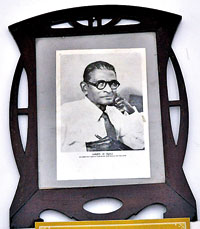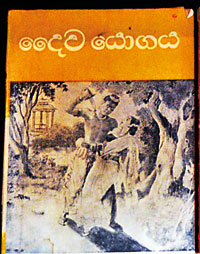Walk into W.A. Silva’s world

Dr. Thamari Thillakawardene
‘Silvermere’ was built in the same decade Queen Victoria celebrated her Golden Jubilee: the 1880s. A neat house with three modest gables, it faced the Wellawatte High Street, where against the palms and the lush greenery the bullock carts were driven and the occasional horse drawn carriage clip-clopped raising puffs of dust. At evening, the residents of the house could look out from the verandah to a scene that is idyllic compared to the heavy traffic of today. The Silvas would surely be shocked by today’s loud clamour and bustle- but it would be a different kind of a shock for them to learn that their road has been renamed after one of their own clan.
Today the wide ‘W. A. Silva Mawatha’ permits Silvermere little privacy, but not so when the namesake of the road lived here. You can picture the original house: well set back, cool, and silent- a prim middle class bungalow- the kind with dark nooks and crannies to foster a young writer’s imagination.
W. A. Silva, who grew up here after being born in 1890, is Ceylon’s Walter Scott, who in the first half of the last century enraptured countless readers with his exciting, suspenseful novels. He had a distinctive flair for the dramatic, the sensational and the chillingly mysterious- whether in his romances, historical novels, detective yarns or short stories. It was in this house, named after a silvery English lake in Surrey with swans and green meadows, that Silva was to plot out all his intriguing stories- among them the classics Kele Handa, Hingana Kolla and Lakshmi (this last partly inspired by H. Rider Haggard’s She).

Portrait of an author: W.A. Silva and (above) some of the first editions of his novels
He would become one of the first best-selling Sinhala novelists, with the exciting Gothic style which the readers of the time were avid for- an escape from their travails into the adventurous, romantic world this new genre from the west promised.
For some reason, he never left the old house his father built.
Abandoned after the death of this great writer in 1957, the house was slowly robbed of personal space, standing too close to the road. Today, however, the building is again vested with a purpose- given a new lease of life by the W. A. Silva Foundation as the W. A. Silva Language and Literature Museum, open to the public since September last year. You walk over a colourful mosaic on the verandah and enter the small hall, where the old wooden carvings of the house and other adornments are displayed.
The museum possesses a few exhibits which commemorate the man still known as the ‘Chakravarti’ (‘universal ruler’) of Sinhalese novelists: the chair and table he used to write and a few personal equipment are preserved in his room. They have also preserved most of his oeuvre- including some first editions of the novels. Alongside are framed contemporary articles and the posters of films inspired by the books- redolent of that period on the cusp of Independence, when there was great interest in the Sinhala arts- especially the new medium of cinema.
The rest of the museum also brings to life the same period- allowing the visitor to step back in time. A giant, cumbersome camera, antique radios, and machines used in cutting and printing books are displayed. An old typewriter and a gramophone stand by, and the blocks used for illustrating books and word blocks; for example there is the block that was used for the title of the Vijayaba Kollaya- the novel that brought to lyrical life the classic story of the regicide (and patricide) by three princes in the 16th Century Kingdom of Kotte.
Dr. Thamari Thillakawardene, curator of the museum, says that the W. A. Silva Foundation hopes to expand what is still a very small property- by adding a library, a coffee parlour, a conference hall and a mini-theatre. Few visitors drop in as of now. Rather sad, seeing that despite a somewhat antiquated language, the prose W. A. Silva produced can still be read with compulsion today- the storytelling genius compounded by the elements of mystery and suspense of which he was master, and the careful historical detail.
The house should be visited by anyone with a penchant for his writing or maybe the films it spawned. It gives insight into what he wrote- that Gothic world comes alive- and for a moment, the nostalgic magic seems more real than the traffic roaring outside in busy Colombo 6.

Hemmed in : W.A. Silva’s ‘Silvermere’ in Wellawatte. Pix by Priyantha Wickramaarachchi





